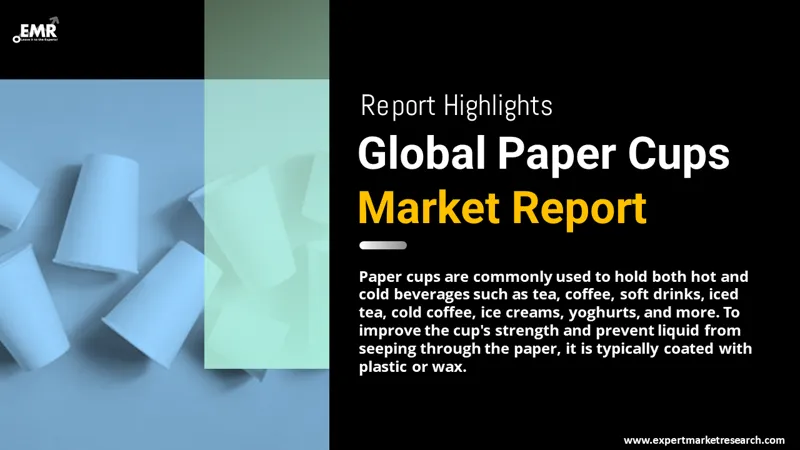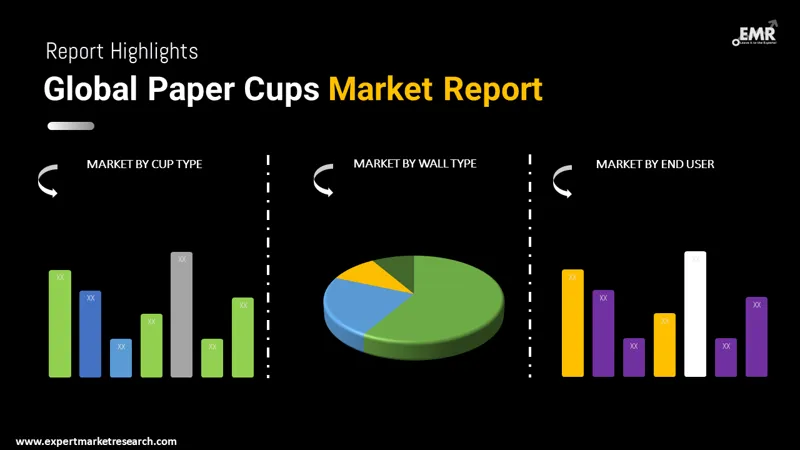
Consumer Insights
Uncover trends and behaviors shaping consumer choices today
Procurement Insights
Optimize your sourcing strategy with key market data
Industry Stats
Stay ahead with the latest trends and market analysis.
The global paper cups market was aided by the growing consumption of the product. In 2025, global consumption reached more than USD 11.57 Billion in 2025 and is expected to increase in the forecast period of 2026-2035 to reach above USD 16.32 Billion by 2035, with consumption growing at a CAGR of 3.50% in the forecast period of 2026-2035.
Base Year
Historical Period
Forecast Period
Compound Annual Growth Rate
3.5%
Value in USD Billion
2026-2035
*this image is indicative*
Paper cups offer numerous advantages, particularly in terms of environmental friendliness and convenience. Made from renewable resources, they decompose more easily than plastic or Styrofoam, and many are now recyclable, reducing waste and conserving resources. Their use of renewable materials, such as sustainably managed wood fibres, also cuts dependency on non-renewable resources. They’re generally free from chemicals found in plastics, making them a safer option for hot beverages, and often feature double-wall construction for improved insulation without the need for additional sleeves which boosts the increasing paper cups demand growth among consumers. Additionally, paper cups are lightweight, easy to dispose of, and customisable with logos or designs, making them a versatile and practical choice for businesses looking to enhance branding while minimising environmental impact.

Read more about this report - REQUEST FREE SAMPLE COPY IN PDF
The hasty life of urban customers acts as a major factor contributing to the demand for single-use packaging, which in turn expands the growth of the paper cup market. Time constraints mean customers are also likely to buy takeaway and food ready for consumption in transit, which in this case calls for the use of paper cups. These cups are specifically intended for such clients in cafes, restaurants, and food service outlets where the pace of service is swift. Therefore, the expanding trend of spending in coffee shops, fast food restaurants, and street food services has led to a consistent rise in the paper cup consumption levels, as they are, an ideal, cost-effective solution to the quick consumption patterns while still being eco-friendly in contrast to plastics.
Customisation options also help the marketing concepts in paper cups where businesses can imprint insignias, prints, and texts that are meant to improve the experience of the end user. In food and beverage companies, the use of customised paper cups works effectively in enhancing their brand image and increasing customer retention levels. Such customisation accelerates the paper cup industry growth, as more and more enterprises recognize the importance of turning their packaging into branded marketing, driving the demand for most paper cups in coffee shops restaurants, and fast-food outlets.
As stated earlier, one of the reasons for the increased use of paper cups is the burgeoning food and beverage industry, especially with the increase in coffee shops, takeaway joints, and online food delivery. Coffee outlets and food delivery businesses are also using the most suitable and convenient paper cups that can be used for both cold and hot drinks and the ease of adapting them to fit the brand. This aids in the paper cup market dynamic and trends since more and more businesses are adopting disposable cups for customer satisfaction and enhanced branding-Sustainability and mobile consumption trend.
The National Restaurant Association forecasts the US food service sector to reach USD 1 trillion in sales by 2024 will significantly boost the paper cup market revenue, as increased demand for takeout and quick-service options drives higher consumption of disposable cups in cafes, restaurants, and delivery services.
In July, food retailing saw a seasonally adjusted increase of 0.2% (USD 30.2 million), with other specialized food retailing rising by 1.3% (USD 13.3 million), as reported by the Australian Bureau of Statistics.
According to the Australian Bureau of Statistics, revealed that total revenue for the fast food and takeaway services sector exceeded 23 billion Australian dollars in 2023, marking a $2.4 billion increase from the previous year.
As per the UK Government, the average household weekly expenditure on food and non-alcoholic drinks was GBP 62.2 in 2022.
In 2022, the food and beverage industry emerged as Canada's largest manufacturing sector by production value, generating $156.5 billion in sales.
In the Twelve months ending March 31, 2024, McDonald's revenue amounted to USD 25.765 billion, reflecting a year-over-year increase of 10.04%. It signifies a strong demand for takeaway options, driving higher consumption of paper cups. As a key supplier of beverages, McDonald's growth directly boosts the paper cup industry revenue.
Dart Container Corporation
F Bender Limited
Jiangsu Yinwang New Material Technology Co., Ltd
Huhtamäki Oyj

Read more about this report - REQUEST FREE SAMPLE COPY IN PDF
“Global Paper Cups Market Report and Forecast 2026-2035” offers a detailed analysis of the market based on the following segments:
Market Breakup by Cup Type
Market Breakup by Wall Type
Market Breakup by End Use
Market Breakup by Region
Hot paper cups are aiding the market expansion of paper cups due to the rising global consumption of tea and coffee.
The hot paper cups segment holds a substantial share of the market as these cups are preferred for serving hot beverages like coffee and tea due to their insulating properties and anti-blocking PE resin covering. On the other hand, the cold paper cups segment also commands a considerable disposable paper cup market share, driven by its lightweight nature and affordability compared to hot cups. Moreover, the continual usage of single-wall products in serving milk-based beverages and flavoured dairy drinks is expected to fuel growth in this segment.
Single-wall paper cups segment dominates the market share due to their cost-effectiveness.
As per paper cups market analysis, single wall cups hold a significant market share, known for their cost-effectiveness and eco-friendly appeal. Companies like BioPak are producing premium single-wall BioCup products made from plant-based bioplastic, reducing carbon emissions, and appealing to environmentally conscious consumers. Additionally, double-wall cups are gaining traction, especially in cafes and coffee shops, where they are used to serve hot beverages like coffee and tea, offering enhanced insulation and a premium image for brands.
The companies specialise in the manufacturing of single-use food service products, such as foam cups, containers, plates, and lids, widely used in food and beverage industries.
Artificial intelligence market
Latin America Explosives Market




*While we strive to always give you current and accurate information, the numbers depicted on the website are indicative and may differ from the actual numbers in the main report. At Expert Market Research, we aim to bring you the latest insights and trends in the market. Using our analyses and forecasts, stakeholders can understand the market dynamics, navigate challenges, and capitalize on opportunities to make data-driven strategic decisions.*
Get in touch with us for a customized solution tailored to your unique requirements and save upto 35%!
In 2025, the global paper cups market attained a value of nearly USD 11.57 Billion.
The market is projected to grow at a CAGR of 3.50% between 2026 and 2035.
The market is estimated to witness healthy growth in the forecast period of 2026-2035, reaching a value of around USD 16.32 Billion by 2035.
The major drivers of the market include the rising demand for disposable cups, growing fast food culture, and the increasing consumer concern about sanitation and hygiene.
Key trends aiding market expansion include the government policies incentivising the recycling of papers cups, rise in home delivery services, growing emphasis on eco-friendly packaging, and growing popularity of coffee shops and fast-food outlets.
The market is broken down into North America, Europe, Asia Pacific, Latin America, the Middle East, and Africa.
By cup type, the market is divided into hot paper cups and cold paper cups.
The wall types include single, double, and triple walled cups.
The dominant application sector of the product is tea and coffee.
The competitive landscape consists of Dart Container Corporation, F Bender Limited, Jiangsu Yinwang New Material Technology Co., Ltd, Huhtamäki Oyj, Georgia-Pacific Consumer Products LP, Pactiv LLC, Go-Pak Group, Konie Cups International, Inc., Graphic Packaging International, LLC, and Grupo Phoenix, among others.
Based on end use, the market is broken down into quick service restaurants, institutional, household, and others.
Explore our key highlights of the report and gain a concise overview of key findings, trends, and actionable insights that will empower your strategic decisions.
| REPORT FEATURES | DETAILS |
| Base Year | 2025 |
| Historical Period | 2019-2025 |
| Forecast Period | 2026-2035 |
| Scope of the Report |
Historical and Forecast Trends, Industry Drivers and Constraints, Historical and Forecast Market Analysis by Segment:
|
| Breakup by Cup Type |
|
| Breakup by Wall Type |
|
| Breakup by End User |
|
| Breakup by Region |
|
| Market Dynamics |
|
| Competitive Landscape |
|
| Companies Covered |
|
| Report Price and Purchase Option | Explore our purchase options that are best suited to your resources and industry needs. |
| Delivery Format | Delivered as an attached PDF and Excel through email, with an option of receiving an editable PPT, according to the purchase option. |
Datasheet
One User
USD 2,999
USD 2,699
tax inclusive*
Single User License
One User
USD 4,399
USD 3,959
tax inclusive*
Five User License
Five User
USD 5,599
USD 4,759
tax inclusive*
Corporate License
Unlimited Users
USD 6,659
USD 5,660
tax inclusive*
*Please note that the prices mentioned below are starting prices for each bundle type. Kindly contact our team for further details.*
Flash Bundle
Small Business Bundle
Growth Bundle
Enterprise Bundle
*Please note that the prices mentioned below are starting prices for each bundle type. Kindly contact our team for further details.*
Flash Bundle
Number of Reports: 3
20%
tax inclusive*
Small Business Bundle
Number of Reports: 5
25%
tax inclusive*
Growth Bundle
Number of Reports: 8
30%
tax inclusive*
Enterprise Bundle
Number of Reports: 10
35%
tax inclusive*
How To Order

Select License Type
Choose the right license for your needs and access rights.

Click on ‘Buy Now’
Add the report to your cart with one click and proceed to register.

Select Mode of Payment
Choose a payment option for a secure checkout. You will be redirected accordingly.
Gain insights to stay ahead and seize opportunities.

Get insights & trends for a competitive edge.

Track prices with detailed trend reports.

Analyse trade data for supply chain insights.

Leverage cost reports for smart savings

Enhance supply chain with partnerships.

Connect For More Information
Our expert team of analysts will offer full support and resolve any queries regarding the report, before and after the purchase.
Our expert team of analysts will offer full support and resolve any queries regarding the report, before and after the purchase.
We employ meticulous research methods, blending advanced analytics and expert insights to deliver accurate, actionable industry intelligence, staying ahead of competitors.
Our skilled analysts offer unparalleled competitive advantage with detailed insights on current and emerging markets, ensuring your strategic edge.
We offer an in-depth yet simplified presentation of industry insights and analysis to meet your specific requirements effectively.
Share